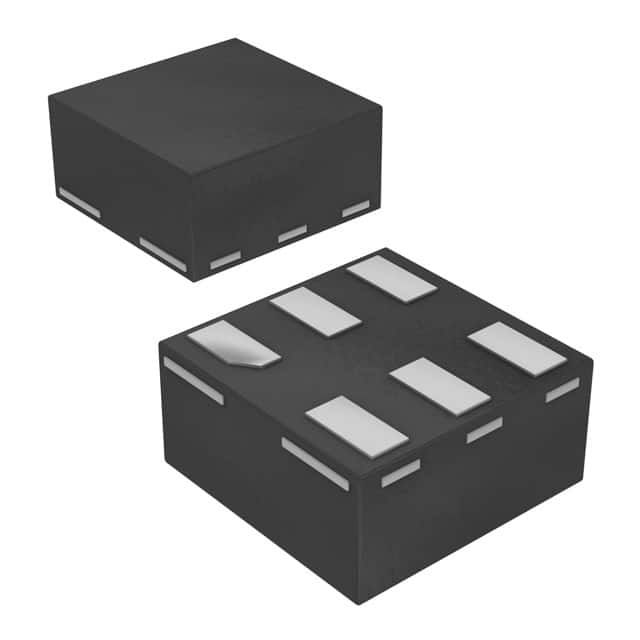Viz Specifikace pro podrobnosti o produktu.

74AUP1G02GN,132
Basic Information Overview
- Category: Integrated Circuit (IC)
- Use: Logic Gate
- Characteristics: Single 2-input NOR gate
- Package: SOT353 (SC-88A)
- Essence: High-speed CMOS technology
- Packaging/Quantity: Tape and Reel / 3000 pieces per reel
Specifications
- Supply Voltage Range: 0.8V to 3.6V
- Input Voltage Range: -0.5V to VCC + 0.5V
- Output Voltage Range: 0V to VCC
- Operating Temperature Range: -40°C to +125°C
- Propagation Delay: 2.5ns (typical) at 3.3V supply voltage
Detailed Pin Configuration
The 74AUP1G02GN,132 has a total of 5 pins: 1. GND (Ground) 2. A (Input A) 3. B (Input B) 4. Y (Output) 5. VCC (Supply Voltage)
Functional Features
- Performs logical NOR operation on two input signals (A and B)
- Provides complementary output (Y) based on the inputs
- Supports high-speed operation with low power consumption
- Compatible with various logic families due to wide supply voltage range
Advantages and Disadvantages
Advantages: - High-speed operation allows for efficient signal processing - Low power consumption helps in reducing overall system energy usage - Wide supply voltage range enables compatibility with different systems
Disadvantages: - Limited to performing NOR operation only - May not be suitable for applications requiring complex logic functions
Working Principles
The 74AUP1G02GN,132 is built using high-speed CMOS technology. It utilizes transistors to implement the NOR gate functionality. When both input signals (A and B) are low, the output (Y) is high. If either or both inputs are high, the output becomes low.
Detailed Application Field Plans
The 74AUP1G02GN,132 can be used in various applications, including: - Digital logic circuits - Microcontrollers - Data communication systems - Consumer electronics - Industrial automation
Detailed and Complete Alternative Models
Some alternative models that provide similar functionality to the 74AUP1G02GN,132 include: - SN74LVC1G02DBVR (Texas Instruments) - MC74VHC1G02DFT1G (ON Semiconductor) - NC7SZ02P5X (Fairchild Semiconductor)
Note: The above list is not exhaustive and there may be other alternative models available in the market.
This entry provides an overview of the 74AUP1G02GN,132 integrated circuit. It includes information about its category, use, characteristics, package, essence, packaging/quantity, specifications, pin configuration, functional features, advantages and disadvantages, working principles, detailed application field plans, and alternative models.
Seznam 10 běžných otázek a odpovědí souvisejících s aplikací 74AUP1G02GN,132 v technických řešeních
Sure! Here are 10 common questions and answers related to the application of 74AUP1G02GN,132 in technical solutions:
Q1: What is the 74AUP1G02GN,132? A1: The 74AUP1G02GN,132 is a single 2-input NOR gate integrated circuit (IC) that is commonly used in digital logic circuits.
Q2: What is the operating voltage range of the 74AUP1G02GN,132? A2: The operating voltage range of the 74AUP1G02GN,132 is typically between 0.8V and 3.6V.
Q3: What is the maximum output current of the 74AUP1G02GN,132? A3: The maximum output current of the 74AUP1G02GN,132 is typically around 32mA.
Q4: Can the 74AUP1G02GN,132 be used in battery-powered applications? A4: Yes, the 74AUP1G02GN,132 can be used in battery-powered applications due to its low power consumption and wide operating voltage range.
Q5: What is the package type of the 74AUP1G02GN,132? A5: The 74AUP1G02GN,132 is available in various package types, such as SOT353 or XSON6.
Q6: What is the propagation delay of the 74AUP1G02GN,132? A6: The propagation delay of the 74AUP1G02GN,132 is typically around 2.5ns.
Q7: Can the 74AUP1G02GN,132 be used in high-speed applications? A7: Yes, the 74AUP1G02GN,132 can be used in high-speed applications due to its low propagation delay and fast switching characteristics.
Q8: Is the 74AUP1G02GN,132 compatible with other logic families? A8: Yes, the 74AUP1G02GN,132 is compatible with various logic families, including CMOS, TTL, and LVCMOS.
Q9: Can the 74AUP1G02GN,132 drive capacitive loads? A9: Yes, the 74AUP1G02GN,132 can drive small capacitive loads without requiring additional buffering.
Q10: What are some typical applications of the 74AUP1G02GN,132? A10: The 74AUP1G02GN,132 can be used in a wide range of applications, including signal inversion, logic gates, level shifting, and interfacing between different voltage domains.
Please note that the answers provided here are general and may vary depending on specific datasheet specifications and application requirements.

